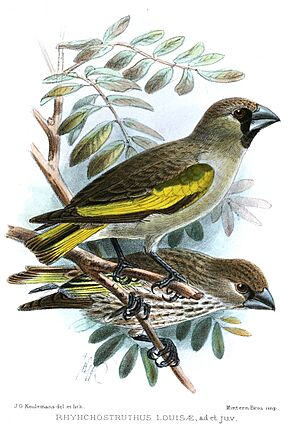Somali golden-winged grosbeak facts for kids
Quick facts for kids Somali golden-winged grosbeak |
|
|---|---|
 |
|
| Conservation status | |
| Scientific classification | |
| Genus: |
Rhynchostruthus
|
| Species: |
louisae
|
| Synonyms | |
|
Rhynchostruthus socotranus louisae Lort Phillips, 1897 |
|
The Somali golden-winged grosbeak (also called the Somali grosbeak) is a special type of finch bird. Its scientific name is Rhynchostruthus louisae. This bird lives only in northwestern Somalia.
For a while, some experts thought it was just a type of Socotra golden-winged grosbeak. But now, most scientists agree that the three different kinds of golden-winged grosbeaks are actually their own separate species.
What Does the Somali Grosbeak Look Like?
Male Somali golden-winged grosbeaks are mostly grey-brown. They have a black beak, which is smaller than the beaks of other golden-winged grosbeak types.
You can spot them by their dark 'mask' on their face. They also have bright yellow patches on their wings and tail, which are quite big!
Female grosbeaks look a lot like the males, but their colors are a bit less bright. Young birds (juveniles) have stripes on their feathers, and their face mask is not very clear.
Where Does the Somali Grosbeak Live?
The Somali golden-winged grosbeak usually lives in places that are between 1,060 and 2,800 meters (about 3,478 to 9,186 feet) above sea level. They like forested areas called wadis, which are valleys that sometimes have rivers.
They also live in areas with scrub, especially in old forests of East African Juniper trees (Juniperus procera). The fruit from these juniper trees seems to be a big part of what they eat.
Why Is This Bird Important?
This bird is the least known of all the golden-winged grosbeaks. Even before the Somali Civil War started in the late 1980s, not much bird research was done in Somalia.
We don't know exactly how many of these birds there are. However, it seems pretty clear that their numbers have gone down since the 1930s. This might be because they are losing their homes (habitat loss). Also, there has been less rainfall in the area recently, which could affect them.
Because of these concerns, when the Somali golden-winged grosbeak was first looked at as its own species in 2008, it was put on the IUCN Red List. It was listed as a Near Threatened species. This means it might become endangered in the future if things don't improve.


